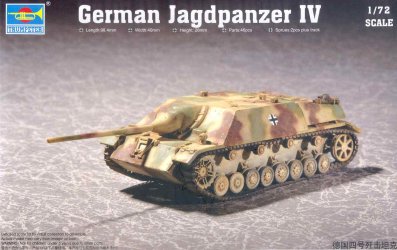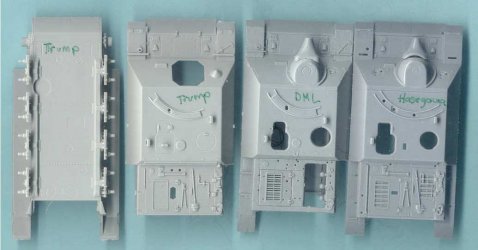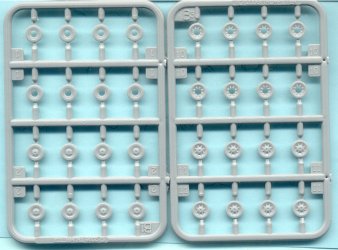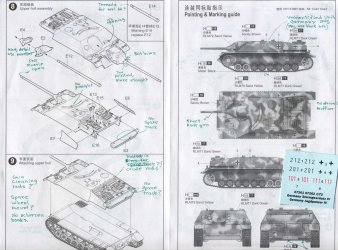|
A Smidgen of History For The Modeler
This World War 2 German tank destroyer is based on the Panzerkampfwagen IV tank and is characterized by the low, well-sloped, thick, armored hull. The reference book Panzer Tracts No.9-2 states that among other German AFVs, this vehicle underwent name changes through its production and use. The earlier produced version of this tank hunter, armed with the shorter 7.5-cm Pak 39 L48 gun, was indeed referred to as the Jadgpanzer IV, or fully the Panzerjaeger IV (7.5 cm Pak 39 L/48) (Sd.Kfz.162) Ausf. F. This version (on the box art below) armed with the long 7.5-cm Pak 42 L/70 gun was referred to as the Panzer IV/70 (V) (Sd.Kfz.162). Seeing that this kit includes gun barrels for both versions I don not consider the incorrect title of Trumpeter's kit to be a significant issue.
What
is supposed to be inside
Let us look at the box art to see what we are supposed to have inside and this is what the modeler first sees before opening the box. Trumpeter is interesting in putting an actual photo of their completed model on their box rather than a painting. Sticking far out in front we see the long 7.5-cm Pak 42 L70 gun, the same gun as mounted in the Panther tank. Behind the gun we see the cast steel gun mantlet and gun mount. Left of the gun mount (our right) is a small rectangular bump that should have holes for the driver's periscope, but the kit does not have these holes; we'll have to cut them in.

Atop the superstructure we can make out several small periscopes that are a little thick and poorly shaped. Atop the rear deck we see the vehicle jack mounted on the engine deck. There is a long armor skirt to help protect the engine sides that in historical photos is removed from some vehicles. The armor side skirt plates covering the suspension is missing from this kit. On the nose is the gun travel lock (travel rest) for the long gun barrel that is folded down. This travel lock was required to secure the gun, especially in rough terrain; is was not mounted on the JgdPz IV fitted with the short Pak 39 L48 gun.
The suspension and tracks is the same as that used by the Pz IV tank except for the steel tired roadwheels mounted on the first two stations. The JgdPz IV L70 was so nose heavy that the steel tired roadwheels were needed to handle the weight. I have read that the excess nose weight caused the vehicle to rock, or waddle front to back leading to its moniker of Guderian's Duck, GuderianEnte (General Heinz Guderian was a significant proponent of this AFV.) The JgdPz IV with the short L48 gun would typically not have the steel roadwheels or the gun travel lock (or barrel rest).
The Kit Parts
I counted 102 light gray, injection molded, styrene plastic parts, though not all these parts will be used. There are two well-detailed soft plastic band tracks. There are no crew figures, no etched brass parts, or cast resin parts included.

Sprue E contains the upper hull parts. In examining the upper hull, note that the gun mount for the Jagdpanzer IV is offset to the right. I find the engine deck acceptable though engine grill slats are not done as well as the Hasegawa or DML. There is a hole for the periscope gunsight but no actual gunsight included with the model.
The gun mount (part E2) appears to make for a secure assembly but does not allow for modeling any traverse or elevation of your model. The gun mantlet (part E4) looks a tad too pointed, tapered, to me. At left are the two gun barrels (parts E12 and E14) though for this hull we should use only part E12. Notice that the Pak 39 L48 barrel lacks the muzzle brake of the initial JgdPz IV version.
In the center is the engine muffler (part E11) but we also have a choice of the Flammentoeter flame suppressor exhaust stacks (parts B6) on sprue-B2. Down at the lower right corner is the gun travel rest and next to it a nicely done shovel, even though the hull has a shovel molded onto the engine deck.
At right is the rear engine plate (part E3) which is missing the spare track that is supposed to be mounted here.

For comparison sake with the Trumpeter at left, I've included partially assembled superstructures from the Dragon Jagdpanzer IV (center) and from Hasegawa (far right). Overall dimensions of the three kits look very close. In response to questions about dimensions and angles of the Dragon and other Jgdpz IV kits, I took some measurements and compared them to Hilary Doyle's plans in Panzer Tracts. None of the three superstructures were perfect compared to Doyle's plans. For example, Hasegawa's roof width is close to true but its height is 0.75-mm too high. Trumpeter's Jgdpz IV superstructure is a little high but pretty close in width.
Molding quality is crisp and fine on all three kits. I've not included an ESCI kit hull but from experience I hold it as the weakest in accurate detail.
Like the Hasegawa release, the Trumpeter model features the tools molded to the hull. The DML kit features many tools molded separately. Unlike the other kits, Trumpeter features the roof hatches molded closed. The Trumpeter kit roof periscopes are a bit clunky and thick. I also judge that DML and Hasegawa engine deck features are better detailed. The roof top ventilator on the Trumpeter and the DML PzJgr IV kits are both too low.
DML and Hasegawa superstructures and chassis both clearly feature the joints for the armor plates but Trumpeter does not.
Notice that the arc-shaped, sliding cover for the gunsight opening for the Trumpeter and the DML models are shorter than that on the Hasegawa model. The Trumpeter and DML appear to represent vehicles with the long L70 gun with 24 degrees of left and right traverse, and the Hasegawa model represents a JgdPz IV with the L48 gun that has 27 degrees of traverse. Based on this, for a historically accurate JgdPz IV, we should not mount the short 7.5-cm L48 gun barrel on this Trumpeter model kit. Conversely we should not use these Trumpeter and DML hulls with the short Pak 39 gun barrel. If you have no choice you can modify the gun sight.
Trumpeter molds the conical machine gun cover onto the glacis while DML and Hasegawa molds the conical covers separately so giving us the option of modeling the MG42 machine hole open. Hasegawa has two machine gun ports indicating an early production vehicle that would have a shorter L48 main gun. All three have the raised viewport on the glacis for the driver's periscopes though Trumpeter does not mold in rectangular holes for the driver's periscopes.
All three hulls have the small raised vents on the brake hatches indicating that none are late production hulls. If we wish a late-production hull we can shave off these vents and add grab handle (see good references).

Here are sprues B1 and B3, of which there are two each. B1 (at left) contains eight paired steel roadwheels (B1 & B2) for a total of 16 steel roadwheels in the kit, so there are extras to use with another model. The wheels look fairly accurate.
At right is one of the two sprues B3 which have the regular rubber-tired roadwheels (parts B10 & B11). The hubs appear to have the forged hubs correct for a late war JgdPz IV. When used with the steel tired roadwheels we will have extras of the rubber-tired roadwheels as well.

Here is one of the two copies of sprue B2 which contains the late-cast sprocket wheels (B3 & B4), the welded tubular idler wheels of a mid-war vehicle (parts B7 & B8). In the center is the optional Flammentoeter flame suppressor exhaust stacks (B6). The exhaust opening will need to be drilled out. At far left are four of the steel return rollers; we have an option of mounting three or four return rollers per side.
At the bottom of the scan is a small section of one of the soft plastic band tracks. The Trumpeter track has nice fine detail that I like better than the CMK aftermarket band tracks but I have found Trumpeter track in other small scale kits to be hard to glue and easy to break. The link detail is certainly better than Hasegawa's band track.
The Assembly Instructions
Trumpeter supplies a multi-step, exploded view assembly instructions that appear clear. I did not note any obvious errors. Step-3 does not clearly show the option of four or three return rollers (parts B9 and B12). On the actual lower hull side (the chassis) there are placement marks for either the two part B12, or a center placement mark for one center return roller part B12.


In Step-9, showing final assembly, we see that certain common features of the Pz IV /70 (V) are missing from the Trumpeter model: no side skirts or mounting hooks, no rooftop gunsight, no spare wheels mounted on the engine deck, no spare track mounted on the rear engine plate.
At left is the five view painting and markings guide for what my references describe as a Pz IV/70(V) of an unidentified unit in Germany, 1945. The drawing shows it with the shorter L48 gun which is historically incorrect. The drawing also shows two steel roadwheels mounted in the first two stations while my photo shows that it had only one steel roadwheel per side.
From a historical photo of British tankers crawling up on the vehicle I believe Trumpeter's interpretation of a three-color soft edge camouflage scheme, and a red vehicle number 101 with white outline is correct. Note that this decal sheet is also used for Trumpeter's StuG IV kit #07261.
Conclusions
I found Trumpeter's JgdPz IV kit, what I also refer to as a Pz IV/70(V), to be a good solid small-scale representation of this AFV with good sharp molding. In an effort to simplify parts, the detail of some areas is soft. For building a fine display model I recommend the Dragon kits of this vehicle, or the Hasegawa kit (as long as you use nice aftermarket tracks). The Trumpeter model will make a fine wargaming kit and with some detailing can be made into a good display model.
Considering that Trumpeter has released kits of the Jagdpanzer IV, StuG IV and Sturmpanzer Brumbaer, I am surprised that Trumpeter has not released any actual Pz IV tanks in 1/72 scale.
References
Panzer Tracts No.9-2, Jagdpanzer, by Thomas Jentz and Hilary Doyle (2012). Superb reference book on the details and technical development with photos and scale plans.
Jagdpanzer IV, Wydawnictwo Militaria 150, (2002) ISBN 83-7219-125-5. Polish publication with English text, color profiles and historical photos.
Panzer IV/70, Wydawnictwo Militaria 152, (2002) ISBN 83-7219-131-X. Polish publication with English text, color profiles and historical photos.
Achtung Panzer website
Toadman's Tank pictures, WWII Axis photo gallery
|